Gastroenterology
- Page Path
-
- HOME
- TOPICS
- Gastroenterology
- Topics
-
- Adolescence Medicine (4)
- Allergy (62)
- Cardiology (81)
- Critical Care Medicine (13)
- Developmental and Behavioral Medicine (24)
- Emergency Medicine (5)
- Endocrinology (61)
- Gastroenterology (71)
- General Pediatrics (54)
- Genetics and Metabolism (26)
- Hematology (18)
- Immunology (16)
- Infection (76)
- Neonatology (Perinatology) (125)
- Nephrology (Genitourinary) (54)
- Neurology (96)
- Nutrition (31)
- Oncology (17)
- Neurobehavior (12)
- Pulmonology (34)
- Rheumatology (3)
- Other (43)
- Original Article
- Gastroenterology
- Adenosine deaminase and interleukin-1 receptor antagonist genetic polymorphisms among obese children with versus without metabolic dysfunction-associated fatty liver disease
- Hala M. Sakhr, Mohammed H. Hassan, Azza Mohamed Taha, Ali Helmi Bakri
- Clin Exp Pediatr. 2025;68(10):808-818. Published online May 29, 2025
-

Question: Is there an association between adenosine deaminase (ADA) G22A and interleukin-1 receptor antagonist (IL-1RN) genetic polymorphisms and pediatric metabolic dysfunction-associated fatty liver disease (MAFLD)?
Finding: The GG genotype and G allele of ADA G22A were significantly associated with obesity but not pediatric MAFLD, while the *1/*2 genotype of the IL-1RN gene was significantly associated with obesity and pediatric MAFLD.
Meaning: The IL-1RN gene may contribute to pediatric MAFLD.
- Dual-strain probiotics Bifidobacterium bifidum and Lactobacillus acidophilus reverse gut dysbiosis in preterm neonates: a randomized controlled trial
- Setthawut Sittiwong, Pornthep Tanpowpong, Pisut Pongchaikul, Pracha Nuntnarumit
- Clin Exp Pediatr. 2025;68(10):763-771. Published online August 6, 2025
-

Question: Can probiotics BB/LA reverse gut dysbiosis in preterm neonates?
Finding: BB/LA supplementation induced more diverse beta diversity and increased relative abundances of Bifidobacterium, Lactobacillus and decreased relative abundance Clostridium.
Meaning: Early BB/LA supplementation could reverse gut dysbiosis in preterm neonates.
- Treatment targeting pediatric inflammatory bowel disease-associated anemia: experience from a single tertiary center
- Ana S.C. Fernandes, Sara Azevedo, Ana Rita Martins, Ana Isabel Lopes
- Clin Exp Pediatr. 2025;68(9):722-731. Published online June 10, 2025
-
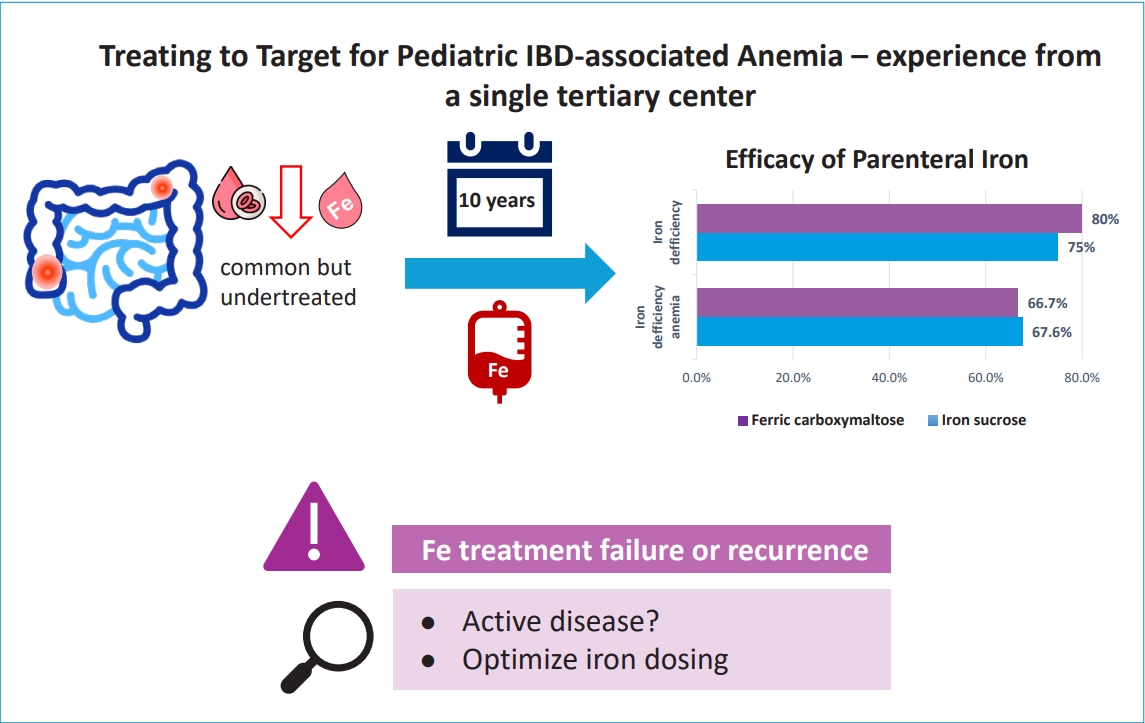
Question: Does treating iron deficiency (ID) using intravenous iron in pediatric inflammatory bowel disease (IBD) feature long-term safety and efficacy?
Finding: Intravenous iron supplementation was safe and effective. However, the ID recurrence rate was higher than expected.
Meaning: Proactive screening and treatment of ID in pediatric IBD are essential. The Ganzoni formula likely underestimates the iron requirements of pediatric patients. Prospective trials are needed to optimize iron treatment dosing.
- Efficacy and safety of carbon dioxide versus room-air insufflation in pediatric colonoscopy: a randomized controlled trial
- Ajay Aravind, Ujjal Poddar, Anshu Srivastava, Moinak Sen Sarma
- Clin Exp Pediatr. 2025;68(8):594-600. Published online March 11, 2025
-
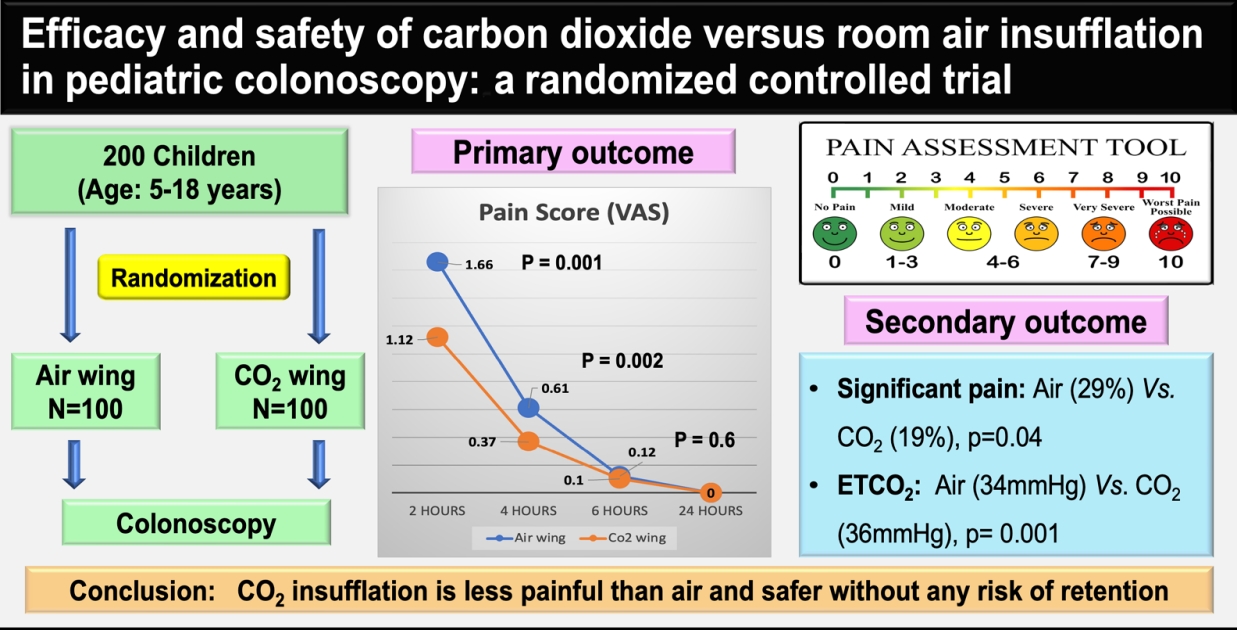
CO2 insufflation has been used instead of air insufflation to reduce postprocedure pain and discomfort in adults; however, adequately powered studies in children are scarce. This randomized controlled trial of 200 children showed that CO2 insufflation reduces postprocedure pain and discomfort during pediatric colonoscopy with no signs of CO2 retention. CO2 insufflation is safe and causes less pain in children.
- Somatic symptom severity during acute illnesses among children with functional gastrointestinal disorders
- Rattanachart Sirinil, Anundorn Wongteerasut
- Clin Exp Pediatr. 2025;68(8):587-593. Published online March 11, 2025
-
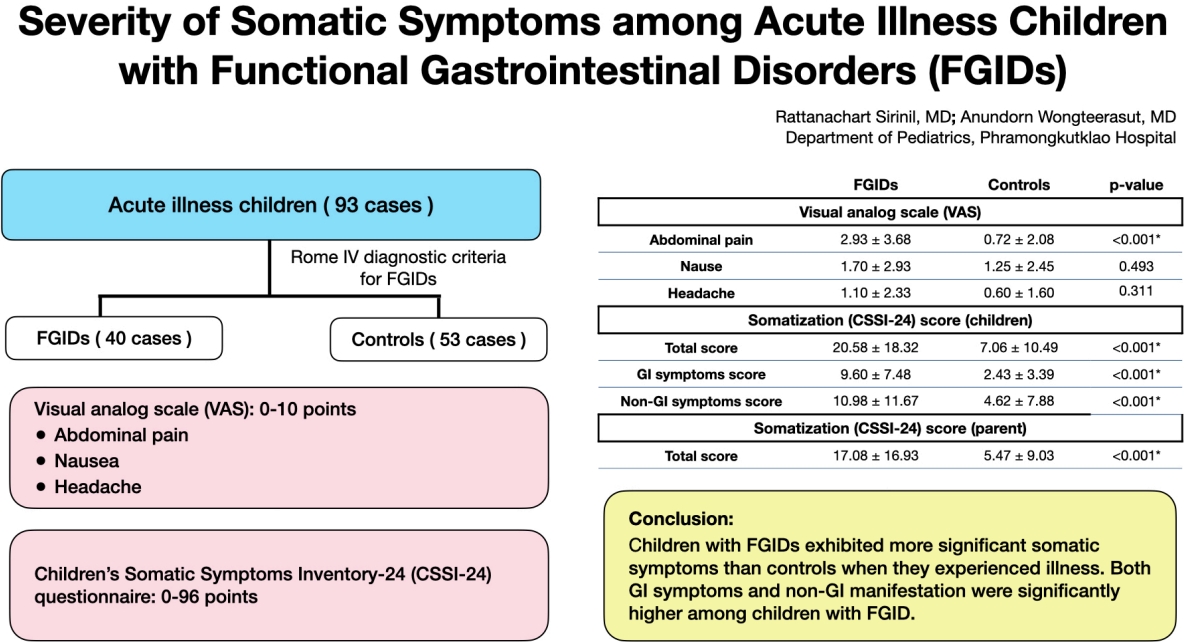
Functional gastrointestinal disorders (FGIDs) are associated with various somatic symptoms measured using a visual analogue scale and the Children’s Somatic Symptoms Inventory-24 questionnaire. Children with FGIDs exhibited more significant somatic symptoms than controls during acute illnesses. Gastrointestinal (GI) and non-GI manifestations are significantly more common in children with FGIDs.
- Perspective
- Gastroenterology
- Metabolic dysfunction-associated steatotic liver disease in children: a practical update based on Indian Society of Pediatric Gastroenterology, Hepatology and Nutrition (ISPGHAN) 2024 guidelines
- Ankit Agrawal, Arghya Samanta
- Clin Exp Pediatr. 2025;68(7):546-550. Published online May 12, 2025
-

- Clinical Note
- Gastroenterology
- Abdominal pain in a young girl: a twist in the tale
- Upasana Ghosh, Ankit Agrawal, Umesh Shukla, Vikas Jain, Deeksha Bhalla
- Clin Exp Pediatr. 2025;68(5):395-397. Published online March 11, 2025
-

· Chronic abdominal pain caused by a gastric trichobezoar is extremely rare among children.
· An indentable epigastric mass is characteristic and upper gastrointestinal endoscopy is diagnostic of a gastric trichobezoar.
· Symptomatic large trichobezoars usually require surgery.
· Neuropsychiatric disorders are often associated with gastric trichobezoar, making a psychiatric evaluation of paramount importance.
- Review Article
- Gastroenterology
- Anxiety disorders presenting as gastrointestinal symptoms in children – a scoping review
- Anjali Kumar, Pramodh Vallabhaneni
- Clin Exp Pediatr. 2025;68(5):344-351. Published online January 13, 2025
-

A positive bidirectional relationship between gastrointestinal disorders and anxiety, but with no clear aetiology, was identified. Factors such as somatisation and pain catastrophising resulted in poorer pain-related outcomes in children. Further studies are required to understand this relationship in order to have targeted treatments and ensure better long term outcomes.
- Clinical Note
- Gastroenterology
- Congenital antral web: rare cause of gastric outlet obstruction successfully managed with endoscopic balloon dilatation
- Upasana Ghosh, Ujjal Poddar, Srinivas Srinidhi Vadlapudi, Moinak Sen Sarma, Anshu Srivastava
- Clin Exp Pediatr. 2025;68(3):266-268. Published online January 13, 2025
-

- Original Article
- Gastroenterology
- Outcome of pediatric inflammatory bowel disease in Asian children: a multinational 1-year follow-up study
- Pornthep Tanpowpong, Suporn Treepongkaruna, James Guoxian Huang, Kee Seang Chew, Karen Sophia Calixto Mercado, Almida Reodica, Shaman Rajindrajith, Wathsala Hathagoda, Yoko Kin Yoke Wong, Way Seah Lee, Marion Margaret Aw
- Clin Exp Pediatr. 2025;68(3):247-256. Published online November 13, 2024
-

Question: Short-term (1-year) follow-up data in pediatric patients with inflammatory bowel disease (IBD), especially in Southeast Asian countries, are limited.
Finding/Meaning: Abdominal pain and pallor rates remained high at 1 year after IBD diagnosis. Three independent factors of 1-year clinical remission for Crohn disease were oral prednisolone, antibiotic, and immunomodulator use at 1-year follow-up. A history of weight loss at diagnosis was the only independent risk factor of IBD flare.
- Review Article
- Gastroenterology
- Practical concepts and strategies for early diagnosis and management of eosinophilic gastrointestinal disorders in East-Asian children
- Byung-Ho Choe
- Clin Exp Pediatr. 2025;68(3):185-198. Published online November 13, 2024
-

Eosinophilic gastrointestinal disorders (EGIDs) often coexist with functional gastrointestinal disorders (FGIDs) and other IgE or non-IgE mediated GI diseases. Diagnosing EGIDs requires a high index of suspicion and a comprehensive approach to differentiate them from conditions like inflammatory bowel disease. Tests such as fecal calprotectin and biopsies aid in severe cases. Maintaining a food diary helps identify triggers for long-term elimination. Awareness and education are key to effective management.
- Original Article
- Gastroenterology
- Differences in immune cells and gene expression in human milk by parity on integrated scRNA sequencing
- Dae Yong Yi, Hong-Jai Park, Min Sun Shin, Hyoungsu Kim, Sang Jin Lee, Insoo Kang
- Clin Exp Pediatr. 2025;68(2):141-152. Published online January 10, 2025
-

Question: Is there a difference in immune cells in human breast milk by parity?
Finding: There were higher proportions of monocytes and T/B cells in the primiparous and multiparous group, respectively. The expression of genes with a direct role in the infant immune system and immune response-related genes were highest in the primiparous group
Meaning: There were parity-dependent differences in the expression of genes between innate and adaptive immune cells.
- Review Article
- Gastroenterology
- Value of transabdominal ultrasonography for diagnosing functional constipation in children: a systematic review and meta-analysis
- Duc Long Tran, Phu Nguyen Trong Tran, Paweena Susantitaphong, Phichayut Phinyo, Palittiya Sintusek
- Clin Exp Pediatr. 2025;68(2):127-135. Published online November 13, 2024
-

Transabdominal ultrasonography is increasingly used as a novel modality for detecting pediatric functional constipation (FC). This systematic review and metaanalysis aimed to assess the diagnostic parameters of FC including rectal diameter (RD) and anterior rectal wall thickness. A systematic search was conducted of the Ovid MEDLINE, Embase, Scopus, and PubMed databases through September 29, 2023, to identify studies comparing RD...
- Letter to the Editor
- Gastroenterology
- Pediatric abdominal ultrasound training program for pediatricians
- Soon Chul Kim
- Clin Exp Pediatr. 2024;67(9):474-476. Published online August 20, 2024
-

- Review Article
- Gastroenterology
- High-resolution anorectal manometry in children
- Yogesh Waikar
- Clin Exp Pediatr. 2024;67(2):57-63. Published online June 14, 2023
-
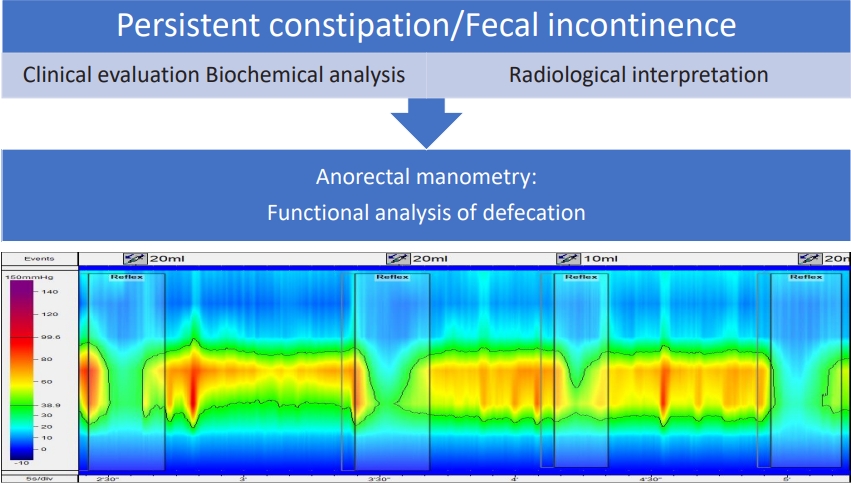
· Anorectal manometry is safe in children.
· Defecation Dyssynergia is one of the commonest cause of chronic constipation.
· Positive Rectoanal inhibiory reflex rules out Hirschsprung's Disease
- Original Article
- Gastroenterology
- Risk factors of prolonged diarrhea in children under 2 years old
- Dedy Rahmat, Agus Firmansyah, Ina S. Timan, Saptawati Bardosono, Joedo Prihartono, Pramita Gayatri
- Clin Exp Pediatr. 2023;66(12):538-544. Published online November 16, 2023
-
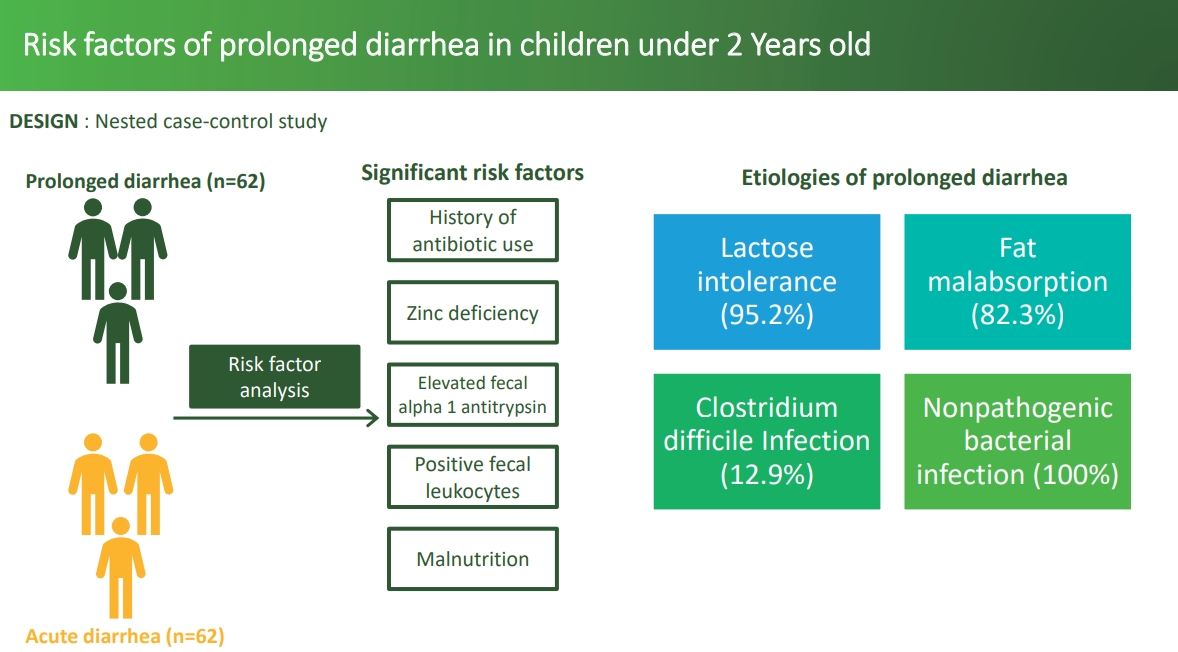
Question: What are the risk factors for prolonged diarrhea in children under 2 years old?
Finding: History of antibiotic use, zinc deficiency, and elevated fecal alpha-1 antitrypsin levels were the main risk factors of prolonged diarrhea in children under 2 years old with acute diarrhea.
Meaning: Rational antibiotic usage is necessary as well as thorough testing of serum zinc level and fecal alpha-1 antitrypsin levels.
- Inferior vena cava to aorta ratio in dehydrated pediatric patients: a systematic review and meta-analysis
- Gilbert Sterling Octavius, Michelle Imanuelly, Johan Wibowo, Nadia Khoirunnisa Heryadi, Melanie Widjaja
- Clin Exp Pediatr. 2023;66(11):477-484. Published online June 14, 2023
-
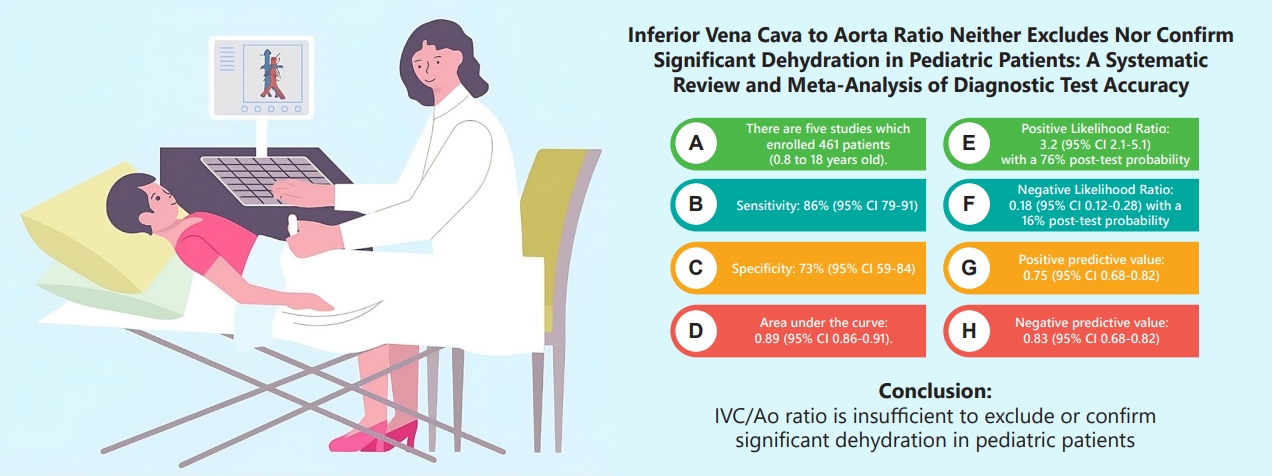
Question: The inferior vena cava to aorta (IVC/Ao) ratio measured via ultrasound has been touted as a promising noninvasive technique to assess clinically significant dehydration in pediatric patients.
Finding: Our meta-analysis found that IVC/Ao ratio had a positive likelihood ratio of 3.2 (95% confidence interval [CI], 2.1–5.1) and negative likelihood ratio of 0.18 (95% CI, 0.12–0.28).
Meaning: Hence, IVC/Ao ratio is insufficient to exclude or confirm significant dehydration in pediatric patients.
- Editorial
- Gastroenterology
- Noninvasive and simple, but accurate? Meta-analysis of evidence-based point-of-care ultrasound for assessing dehydration in children
- Jin-Hee Oh
- Clin Exp Pediatr. 2023;66(11):475-476. Published online July 11, 2023
-
· Point-of-care ultrasound imaging, including measurement of the inferior vena cava/aorta ratio, is powerful for evaluating the hemodynamic status of pediatric patients.
· Owing to the limited feasibility of randomized clinical trials and insufficient data in children, imaging tools require validation.
· Objective validity meta-analyses of imaging studies can affect clinical decision-making and serve as a cornerstone for evidence-based practice in pediatrics.
- Original Article
- Gastroenterology
- Relationship between nonalcoholic fatty liver disease and hyperandrogenemia in adolescents with polycystic ovary syndrome
- Ozlem Kara, Hanife Aysegul Arsoy, Murat Keskin
- Clin Exp Pediatr. 2023;66(9):395-402. Published online June 14, 2023
-

Question: Is polycystic ovary syndrome (PCOS) a risk factor for nonalcoholic fatty liver disease (NAFLD) in adolescents?
Finding: The frequency of NAFLD did not increase in adolescents with PCOS. However, hyperandrogenemia was a risk factor for NAFLD.
Meaning: Adolescents with PCOS and hyperandrogenemia should be closely monitored for hepatic steatosis.
- Review Article
- Gastroenterology
- Prevalence, risk factors, and treatment of small intestinal bacterial overgrowth in children
- Yu Kyung Cho, Jin Lee, Chang Nyol Paik
- Clin Exp Pediatr. 2023;66(9):377-383. Published online August 21, 2023
-
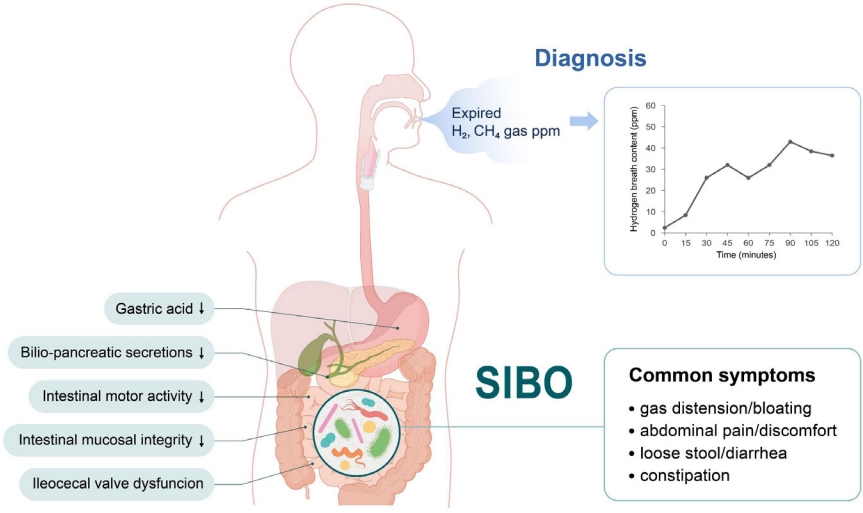
· Pediatric small intestinal bacterial overgrowth (SIBO) manifestations range from nonspecific abdominal symptoms to malabsorption or malnutrition.
· SIBO is prevalent in children and adolescents with functional abdominal pain disorders.
· Predisposing factors include disturbed intestinal motility, altered anatomy, and/or abnormal body defense systems against intestinal bacteria.
· Breath tests are safe and noninvasive.
· Treatment principles include managing predisposing conditions, nutritional support, symptom control, and antibiotics.
- Original Article
- Gastroenterology
- Assessing indicators and clinical differences between functional and organic childhood constipation: a retrospective study in pediatric gastroenterology clinics
- Hasan M. Isa, Fatema A. Alkharsi, Fatema A. Salman, Maryam S. Ali, Zahra K. Abdulnabibi, Afaf M. Mohamed
- Clin Exp Pediatr. 2023;66(7):296-306. Published online June 14, 2023
-
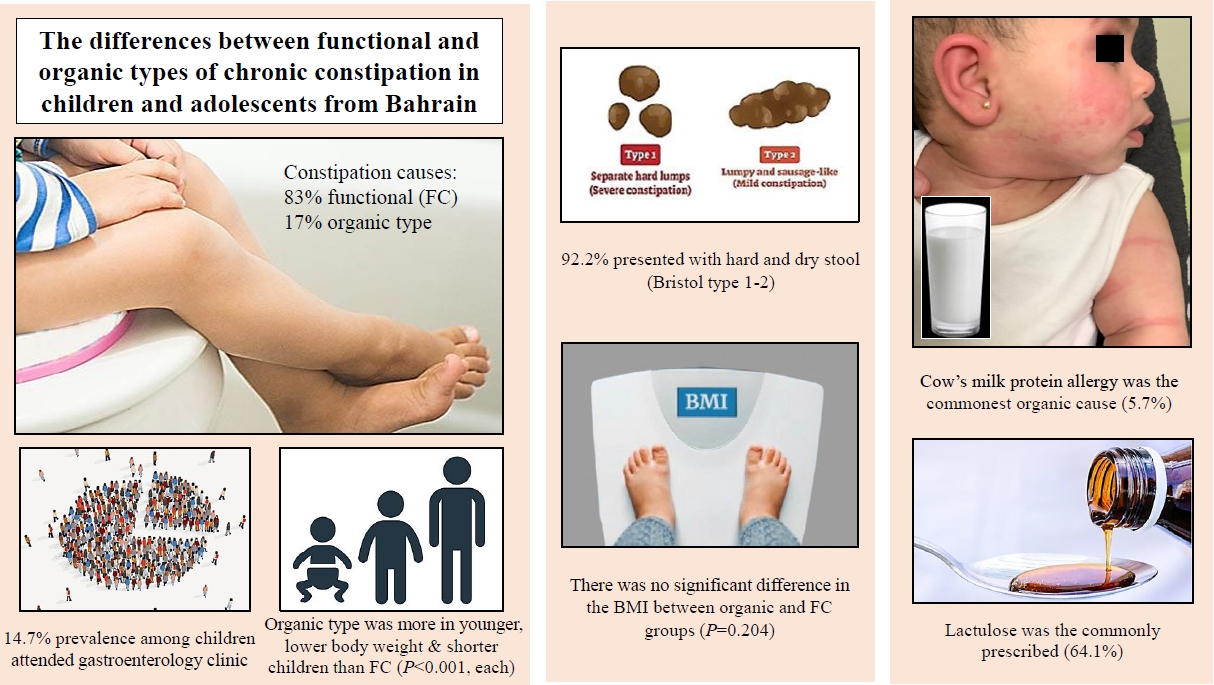
Question: What causes childhood constipation, and what can predict organic constipation?
Finding: Constipation represents 14.7% of gastroenterology visits. Functional constipation is more common among constipation types, while organic constipation is more common in young children and those with a low body weight, stunted growth, mucus in the stool, and associated diseases.
Meaning: Younger children and those with lower growth or mucus in the stool should be assessed for underlying organic causes of constipation.
- Editorial
- Gastroenterology
- Gut microbiota’s impact on obesity
- Sujin Jeong
- Clin Exp Pediatr. 2023;66(7):294-295. Published online June 14, 2023
-
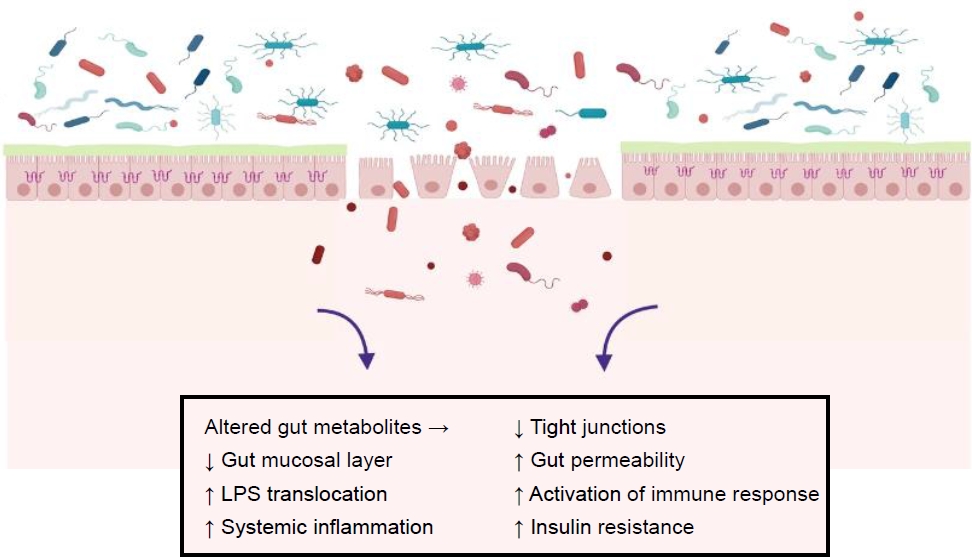
· An imbalance of the gut microbiota with a relative increase in Firmicutes versus Bacteroidetes is associated with the pathogenesis of obesity.
· Dysbiosis is associated with microbial genes associated with short-chain fatty acids (SCFA) production and increased colonic SCFA levels. SCFAs have also been shown to regulate appetite and satiety hormones, which can affect food intake and energy balance.
· A dietary high-fat intake is reportedly associated with increased plasma lipopolysaccharide. Altered Toll-like receptor-4 signaling leads to propagating the cascade of further inflammation and promoting insulin resistance.
- Recent advances in epigenetic mechanisms, diagnosis, and treatment of pediatric gastrointestinal allergic disorders
- Eell Ryoo
- Clin Exp Pediatr. 2023;66(6):250-251. Published online May 19, 2023
-
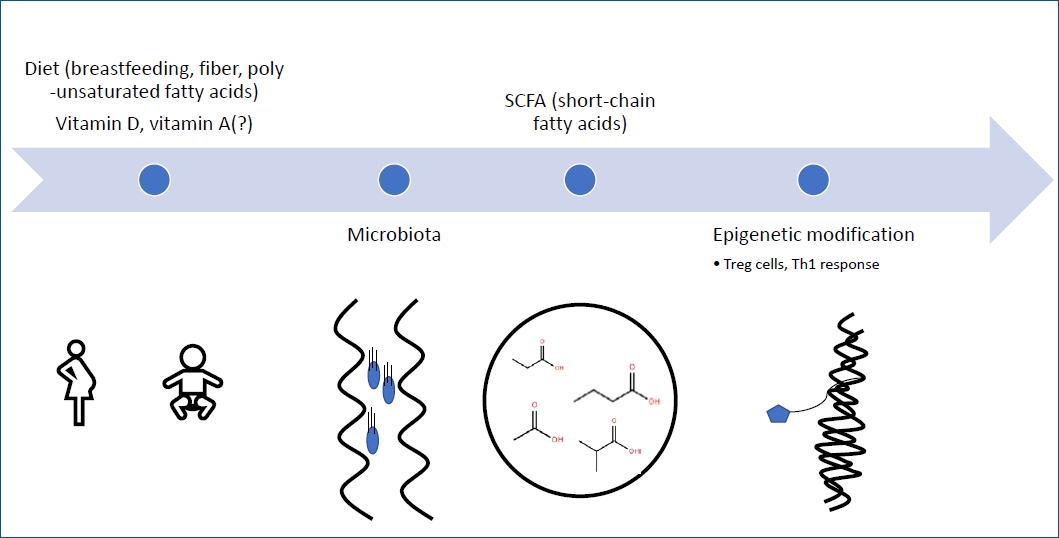
· Epigenetic mechanisms are involved in rapidly increasing food allergy.
· There is still no definitive way to diagnose food allergy.
· Early introduction of peanuts, eggs, and cow’s milk reduces food allergy incidence.
· Administration of probiotics such as Lactobacillus rhamnosus GG, Bifidobacterium bifidum can partially reduce the occurrence of allergic symptoms.
- Review Article
- Gastroenterology
- Update on eosinophilic gastrointestinal disease beyond eosinophilic esophagitis in children
- Hye Ran Yang
- Clin Exp Pediatr. 2023;66(6):233-239. Published online January 3, 2023
-
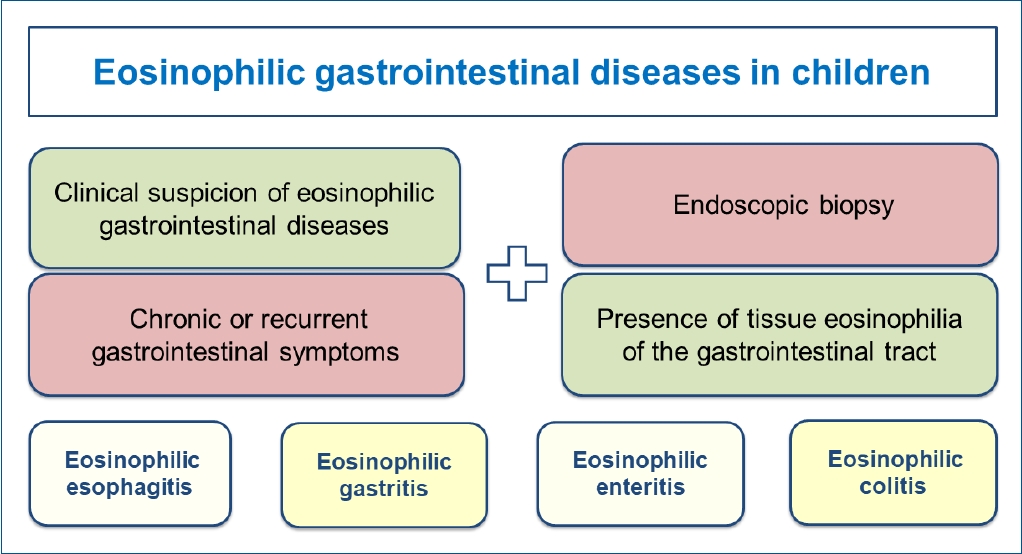
· Eosinophilic gastrointestinal disease (EGID) is uncommon, with a prevalence of 1–30/100,000 in the general population; however, it is increasing worldwide.
· The diagnosis of EGID is based on histopathological findings of endoscopic mucosal biopsy in which tissue eosinophils are counted in each gastrointestinal tract segment of patients with chronic or recurrent gastrointestinal symptoms.
· Individualized treatment strategies, including adequate dietary and pharmacological therapy, may help improve outcomes of children with EGID.
- Role of social media use in onset of functional gastrointestinal disorders in children
- Mauro Cinquetti, Vanessa Dargenio, Michele Fingerle, Carolina Marchiotto, Marco Biasin, Massimo Pettoello Mantovani, Flavia Indrio
- Clin Exp Pediatr. 2023;66(6):226-232. Published online December 21, 2022
-

· Social media use can cause adverse health outcomes, including gastrointestinal disorders, in children and adolescents.
· Recent findings have shown a high prevalence of social media use and decreased well-being in patients with functional gastrointestinal disorders.
· The biopsychosocial nature of functional gastrointestinal disorders and the clear influence of social media on the psychosocial lives of children suggests the likely involvement of social media in their development.
- Editorial
- Gastroenterology
- Is there a link between social media usage and functional gastrointestinal disorders in children?
- Hae Jeong Lee
- Clin Exp Pediatr. 2023;66(4):169-170. Published online March 23, 2023
-
Social media use has potential benefits and risks, including links to adverse health problems in children such as functional gastrointestinal disorders (FGIDs). Screen time control, emotional support, and parental guidance can help children navigate social media safely and reduce the risk of developing FGIDs.
- Review Article
- Gastroenterology
- High-resolution esophageal manometry in children
- Yogesh Waikar
- Clin Exp Pediatr. 2023;66(4):155-160. Published online October 17, 2022
-
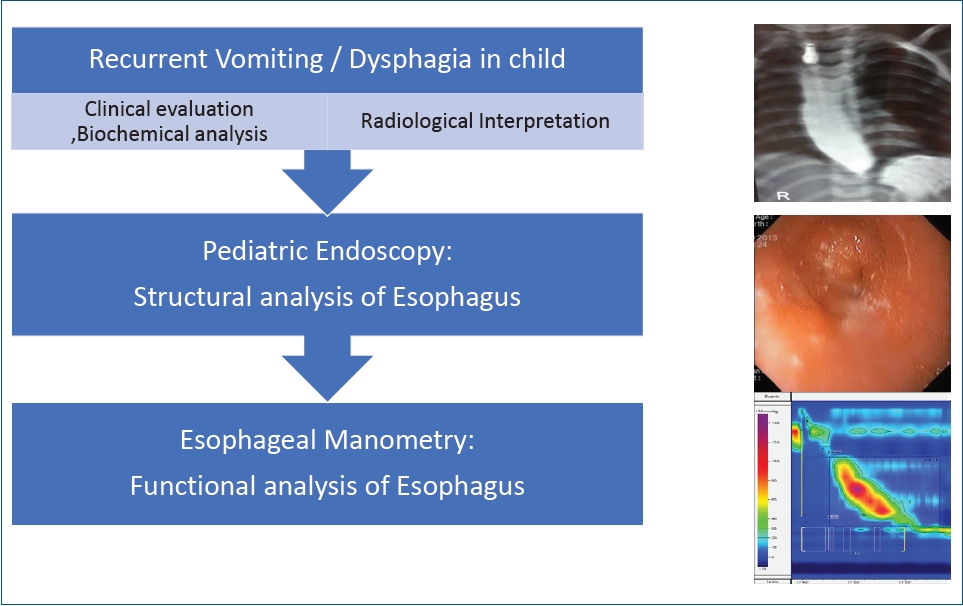
High-resolution esophageal manometry can be safely performed in children where recurrent vomiting and persistent dysphagia is the working diagnosis after excluding nonluminal and structural obstructive pathologies using pediatric upper gastrointestinal endoscopy. Normal manometry values are available. Clinical picture, biochemical tests, radiological interpretation, and endoscopic findings with manometry completes the analysis of patients with recurrent vomiting and dysphagia.
- Liver fibrosis in children: a comprehensive review of mechanisms, diagnosis, and therapy
- Elif Ozdogan, Cigdem Arikan
- Clin Exp Pediatr. 2023;66(3):110-124. Published online December 19, 2022
-
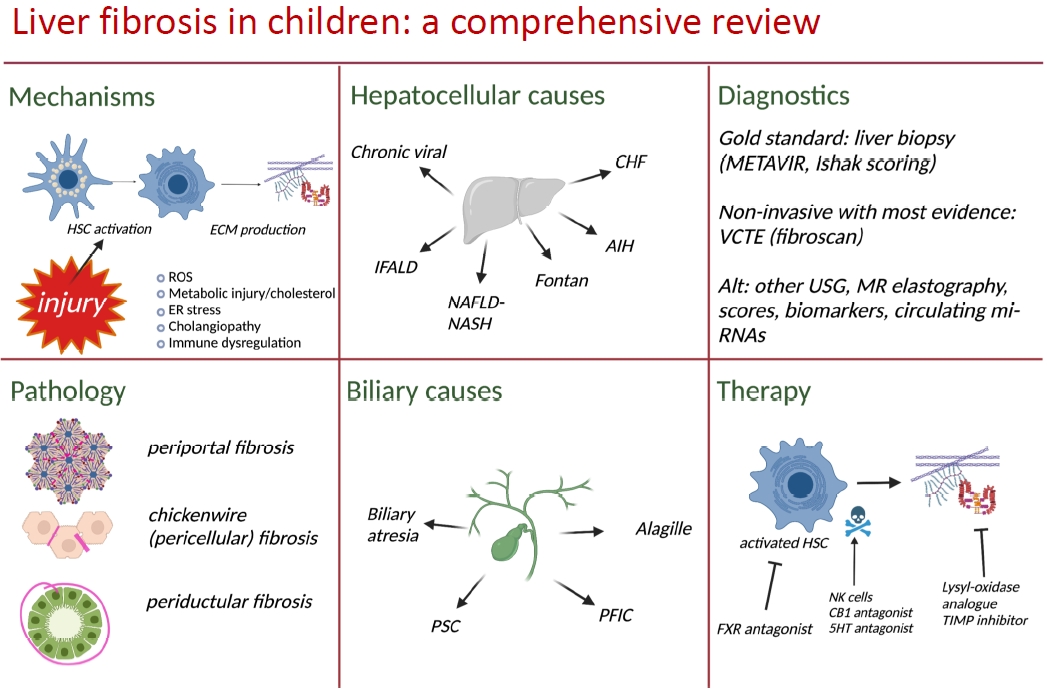
· Chronic liver diseases in children are heterogenous but converge in the common pathway of fibrosis.
· Much of the literature on mechanisms of fibrogenesis focus on adults but pediatric physiology has documented differences.
· Understanding of these distinctions are necessary to define, treat, and prevent fibrosis.
· Current management of liver fibrosis relies heavily on liver biopsy. Multiple tools have shown high diagnostic performance in pediatric and adult populations. Large, multicenter studies are needed for validation.
- Original Article
- Gastroenterology
- Association between maternal weight gain during pregnancy and child’s body mass index at preschool age
- Jeewon Shin, Yoowon Kwon, Ju Hee Kim, Su Jin Jeong
- Clin Exp Pediatr. 2023;66(2):76-81. Published online November 30, 2022
-

Question: What are the risk factors of newborn birth weight? Does gestational weight gain and prepregnancy body mass index affect childhood weight?
Finding: Excess maternal weight gain increases the risk of overweight/obesity, newborn birth weight, and child body mass index at 4–6 years.
Meaning: Maternal weight control before and during pregnancy should be well controlled.
- Review Article
- Gastroenterology
- Current diagnosis and image-guided reduction for intussusception in children
- Jisun Hwang, Hee Mang Yoon, Pyeong Hwa Kim, Ah Young Jung, Jin Seong Lee, Young Ah Cho
- Clin Exp Pediatr. 2023;66(1):12-21. Published online July 4, 2022
-
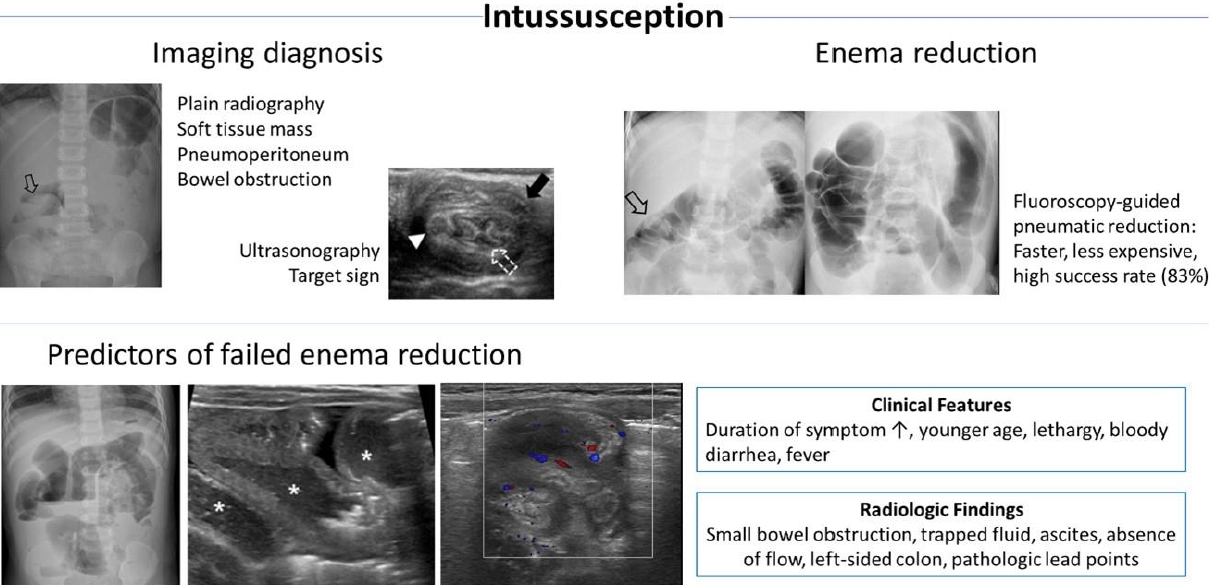
· Intussusception, the most common cause of small bowel obstruction in young children, has an overall incidence in Korea of 28.3 cases per 100,000 person-years.
· Its cause is idiopathic inmost cases, although viral or bacterial gastroenteritis has beenpostulated as a cause. Approximately 4% of children have pathological lead points for intussusception, and Meckel’s diverticulum is the most common cause.
· Intussusception in preterm infants is extremely rare. Older children (>5 years of age) are at increased risk of pathological lead points.
-

-
-
6.02024CiteScore98th percentilePowered by
-
Impact Factor3.6
-
- TOPICS
- ARTICLE CATEGORY
- Editorial Office
-
Korean Pediatric Society
#1606 Seocho World Officetel, 19 Seoun-ro, Seocho-ku, Seoul 06732, Korea
Tel: +82-2-3473-7306 Fax: +82-2-3473-7307 E-mail: office@e-cep.org
Clinical and Experimental Pediatrics is an open access journal. All articles are distributed under the terms of the Creative Commons Attribution NonCommercial License (http://creativecommons.org/licenses/by-nc/4.0/)
Copyright © 2025 by Korean Pediatric Society.











